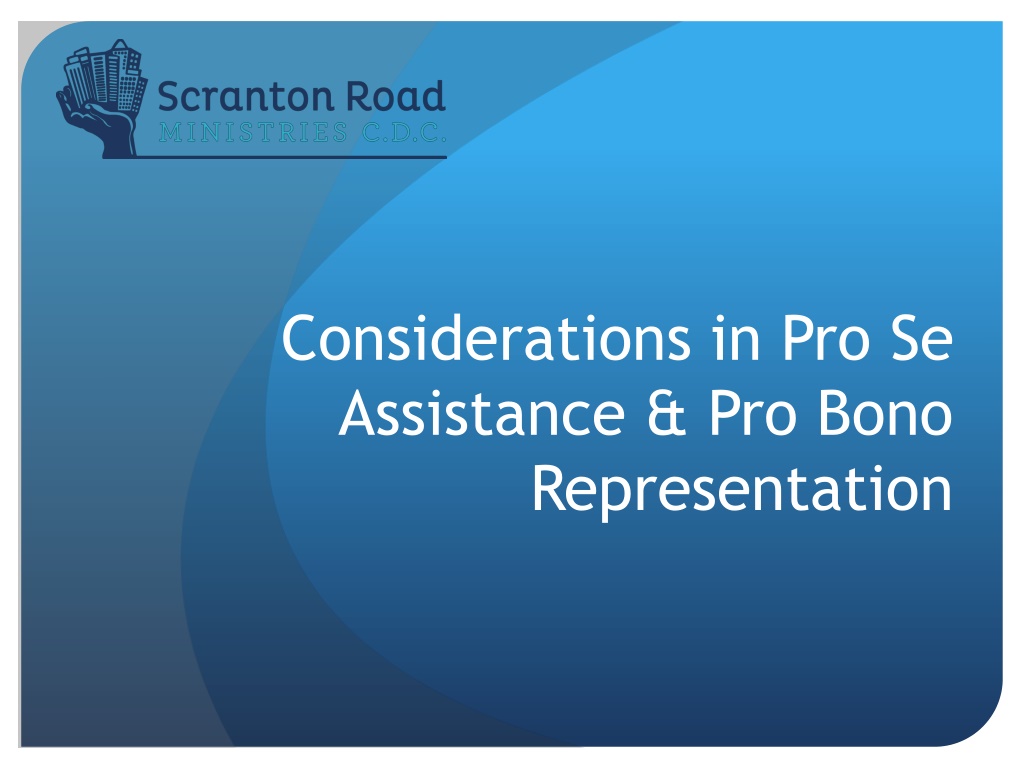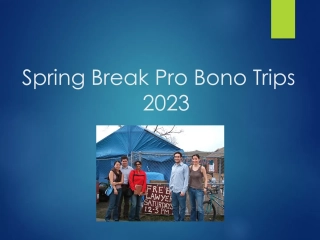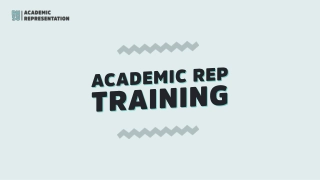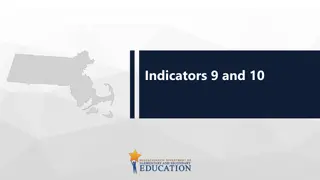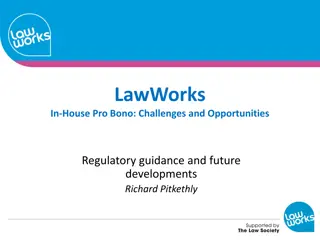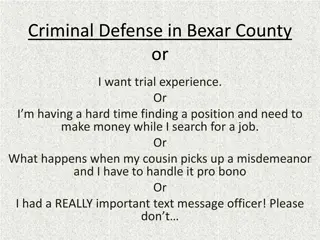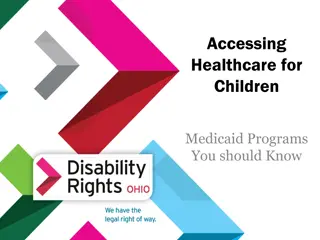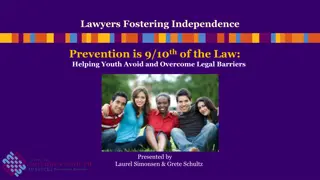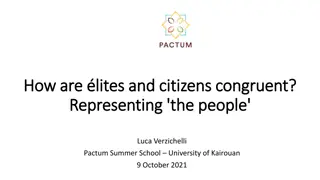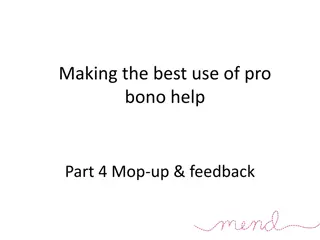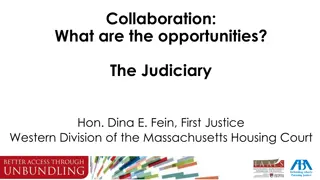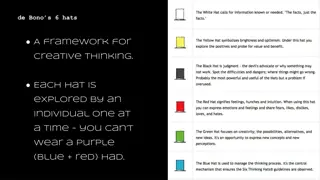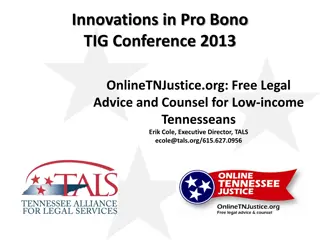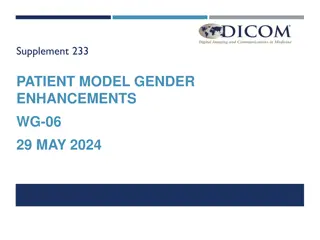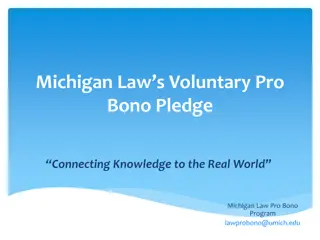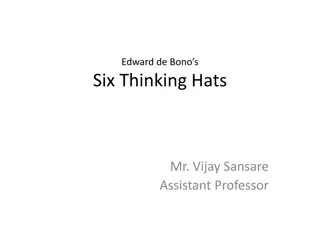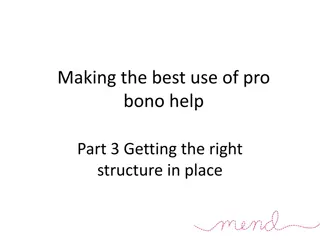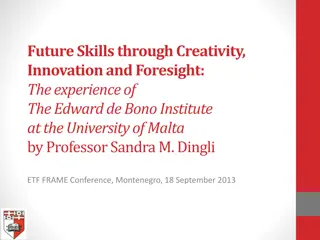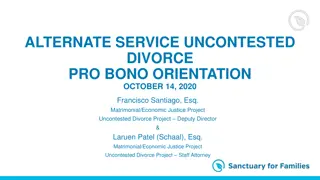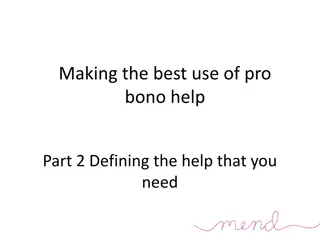Understanding Pro Se Assistance and Pro Bono Representation
This material delves into the considerations, course outlines, justifications, and constitutional basis for assisting pro se litigants and encouraging pro bono representation. It covers the need for self-representation, limitations to the right, the increase in pro se litigants, and the constitutional background supporting self-representation rights in the legal system.
Download Presentation

Please find below an Image/Link to download the presentation.
The content on the website is provided AS IS for your information and personal use only. It may not be sold, licensed, or shared on other websites without obtaining consent from the author. Download presentation by click this link. If you encounter any issues during the download, it is possible that the publisher has removed the file from their server.
E N D
Presentation Transcript
Considerations in Pro Se Assistance & Pro Bono Representation
Course Outline (Hour 1) Assisting Pro Se Litigants Defining & Understanding Pro Se Pro Se Assistance & Ltd. Scope Representation UPL for Unrepresented/Pro Se Litigants Addressing Barriers to Pro Se Litigants Pro Se Forms & Resources Coaching for Pro Se Court Appearances Q&A/Discussion Questions
Course Outline (Hour 2) Encouraging Pro Bono Representation Establishing Need for Pro Bono Services Benefits for Pro Bono Practitioners Barriers for Pro Bono Representation Opportunities for Pro Bono Assistance Low-Bono Representation Q&A/Discussion Questions
Justifying Pro Se Assistance Pro Se Latin for on one s own behalf Increase in Pro Se Litigants In Family Law cases, 67% of filings in CA, 73% in FL, 70% in WI (1) In more than 70% of civil cases, families are going to court alone (2) Old adage: One who is his own lawyer has a fool for a client. Forcing a lawyer upon an unwilling defendant is contrary to his basic right to defend himself. (Faretta v. California) (3) Defendants should be made aware of the dangers and disadvantages of self-representation so that he knows what he is doing and his choice is made with his eyes open (4) (1) Madelynn Herman (September 25, 2006). "Self-Representation: Pro Se Statistics". National Center for State Courts. Archived from the original on 2012-05-04. (2) http://connecticutlawreview.org/files/2015/01/9-Steinberg.pdf (3) Faretta v. California, 422 U.S. 806 (1975) (4) Id.
Constitutional Basis for Pro Se Representation Faretta vs. California recognizes the right to represent oneself "[i]n the federal courts, the right of self-representation has been protected by statute since the beginnings of our Nation. Section 35 of the Judiciary Act of 1789, 1 Stat. 73, 92, enacted by the First Congress and signed by President Washington one day before the Sixth Amendment was proposed, provided that 'in all the courts of the United States, the parties may plead and manage their own causes personally or by the assistance of counsel. Limitations to Right to Self-Representation McKaskle v. Wiggins Court may appoint standby counsel over pro se defendant s objection Martinez v. Court of Appeals of CA No constitutional right to be pro se during criminal appeals Indiana v. Edwards Questions modern relevancy of Faretta with the increased availability of attorneys Other Limitations: Disruptive behavior, Use for Delay, Untimely, Hybrid Representation, Representing Corporations McKaskle v. Wiggins, 465 U.S. 168 (1984). Martinez v. Court of Appeals of Cal., 528 U.S. 152 (2000). Indiana v. Edwards, 554 U.S. 164 (2008).
Why Pro Se? University of MD Law School Study: 57% - Could not afford an attorney 18% - Did not want to spend the money 21% - Believed their case was simple and they didn t need an attorney 45% of pro se litigants believe lawyers are more concerned with their own self promotion than their client s best interest ABA Legal Needs Study Community Access to Justice Limited access to counsel Access to limited counsel
Pro Se Assistance & Limited Scope Representation Legal advice has the following characteristics: Requires legal knowledge, skill, education, and judgment Applies specific law to a particular set of circumstances Affects someone s legal rights or responsibilities Creates rights and responsibilities in the advice-giver Land Title Abstract & Trust Co. v. Dworken, 193 N.E. 650 (1934) If a pleading is prepared in any substantial part by a member of the bar, it must be signed by that attorney to avoid misrepresentation. Ostevoll w. Ostevoll, 2000 WL 1611123 (S.D. Ohio)
Ohio Rules of Professional Conduct & Limited Scope Representation Rule 1.2 A lawyer may limit the scope of representation if the limitation is reasonable under the circumstances and communicated to the client, preferably in writing. An agreement between the lawyer and the client regarding the scope of the representation may limit the matters for which the lawyer is responsible. Although [agreement] does not exempt a lawyer from the duty to provide competent representation, the limitation is a factor to be considered when determining the legal knowledge, skill, thoroughness, and preparation reasonably necessary for the representation. Task force recommends clarification term reasonable under the circumstances Practical application is this reasonable? Rule 4.3 - Dealing with Unrepresented Parties Rule 6.5 Lawyers who, with a nonprofit organization, provide short-term limited legal services not expected to continue are subject to: Rules 1.7 & 1.9 (a) If conflict of interest is known Rule 1.10 if lawyer knows another lawyer in the same firm is disqualified by 1.7/1.9(a)
Unauthorized Practice of Law by and for Pro Se Litigants ORC 4705.07 Unauthorized practice. (A) No person who is not licensed to practice law in this state shall do any of the following: (1) Hold that person out in any manner as an attorney at law; (2) Represent that person orally or in writing, directly or indirectly, as being authorized to practice law; (3) Commit any act that is prohibited by the supreme court as being the unauthorized practice of law.
Unauthorized Practice of Law for Pro Se/Unrepresented Litigants Prohibits non-attorneys from providing legal advice, preparing legal papers or pleadings, charging fees, carrying out legal proceedings in court LCBA v. Zubaidah Not UPL: Community activism, character/reference letter, nonlegal advice UPL: Signing formal agreements, presentation of legal arguments in court CBA v. Henley Advising of legal rights and terms/conditions of settlement Disclaimers, good intentions, or free services do not excuse UPL Examples Friends/Family Members drafting pleadings or providing court representation Notarios Community Activists providing representation Clinic volunteers/paralegals/law students Lorain Cty. Bar Assn. v. Zubaidah, 140 Ohio St. 3d 495, 496 (2014). Cleveland Bar Assn. v. Henley, 766 N.E.2d 130 (2002).
Barriers to Pro Se Litigants Success Rates Those represented by an attorney before administrative agencies (SSI, immigration, unemployment) have up to 2-3 times more success than those unrepresented by counsel 74% of non-detained immigrants with counsel prevailed in their cases, as compared to 13% of those without counsel Discuss: What are some potential barriers to success for pro se litigants?
Barriers to Pro Se Litigants Lack of knowledge of law Lack of knowledge of procedure Literacy/education/technology limitations Effective Communication Language limitations Disability limitations Transportation Decorum/Presentation
Barriers to Pro Se Litigants Addressing Limitations Lack of legal/procedural knowledge Pro Se Offices/Assistance Juvenile Justice Center Pro Se Offices - 216-443-3149; 9300 Quincy Ave. 2nd floor Walk-in Hours 9am-1pm; 2pm-4pm Monday- Friday Domestic Relations Information Center - 1 W. Lakeside Ave., Room 306, Cleveland, OH 44113 Housing Court Escrow/Mediation by request - 1200 Ontario St., Room 13B, Cleveland, OH 44113; (216) 664-4295 Small Claims Video and Brochure available for Cleveland Municipal Court Cleveland Mediation Center - 2012 W 25th St #412, Cleveland, OH 44113 Neighbor disputes, LL/Tenant, visitation/custody, divorce/ dissolution, bullying, school/student/parent concerns
Barriers to Pro Se Litigants Addressing Limitations Procedural Limitations Filing Fees Poverty Affidavits/Affidavits of Indigency Income, Expenses, Family Size Some courts will defer filing fees instead of waiving Service Who to serve How to serve Standing - Are they the right party? Are they litigating against the right party? Managing Deadlines Transportation/Access
Barriers to Pro Se Litigants Effective Communication with Assisting Attorney Client-focus vs. Attorney-focus Who makes decisions? How are plans created? Empathy vs. Sympathy Are you feeling with or for the client? Are you hearing what the incident means to them or what it would mean to you? Non-Judgmental vs. Judgmental Language Help me understand vs. That makes no sense The law requires/the judge will look for.. vs. That won t work Yes, and vs. Yes, but Consider: Race, Culture, SES, Domestic Violence Victims, Mental Illness, Substance abuse, Criminal Records Do s and Don ts of Interviewing Low-Income Clients. Jaime Moore, JD, Andrya Soprych, LCSW. Christian Legal Society Conference, October 2015
Barriers to Pro Se Litigants Language 27 court forms available in five major languages: Arabic, Chinese, Russian, Somali, and Spanish.You must still complete and file the English version of these translated forms. Available at http://www.supremecourt.ohio.gov/JCS/interpreterSvcs/forms / (Guardianship; Criminal; Protection Order; Small Claims) Must still complete English versions Request an interpreter - call 1.888.317.3177, M-F, 8 AM to 5 PM Courts encouraged to provide interpretation services where they protect a person s rights The court interpreter is a neutral party who only interprets the proceedings and facilitates communication If a pro se litigant is denied access to an interpreter, you can initiate a complaint by callingthe Supreme Court of Ohio Language Services Program at 1.888.317.3177
Barriers to Pro Se Litigants Disability Disability Limitations Courtroom accessibility ASL, Service Dogs, Addressing Witnesses, Microphones http://disabilityjustice.org/courtroom-access-and- accommodations/ Supreme Court of Ohio Bench Card 2.0 Working with Interpreters for Deaf & Hard of Hearing Persons in the Courtroomhttp://www.sconet.state.oh.us/publications /interpreter_services/DeafHOHbenchcard.pdf
Forms & Resources for Pro Se Litigants & Pro Bono Attorneys Pro Se Offices Forms & Assistance, Procedural Information Legal Aid Resource Center - https://lasclev.org/resources/overview/ Topical brochures covering substantive law & procedure Ohio Legal Services - http://www.ohiolegalservices.org Substantive Law, Procedure, Tips for Pro Se Litigants Keys to the Courtroom OSBF - http://www.fcmcclerk.com/resources/pdf/KeysBrochure2.pdf Procedure, Terminology, Finding Substantive Law Ohio Supreme Court Guide for Pro Se Litigants - http://www.supremecourt.ohio.gov/Publications/filingGuide.pdf Common mistakes, Terminology, etc. Cleveland Law Library - http://clevelandlawlibrary.org/ Legal research, forms, etc.
Forms & Resources for Pro Se Litigants Area-of-Law Specific Resources Cleveland Tenants Organization (Landlord/Tenant) - http://www.clevelandtenants.org/ Housing Research & Advocacy Center (Housing Discrimination) - http://www.thehousingcenter.org/ NHS Consumer Law Center (Credit/Debt, Consumer Law) - http://www.nhsconsumerlawcenter.org/ Reentry Coalition (Record Sealing/CQE) - www.reentrycoalition.ohio.gov Pro Seniors (Elder Law, Medicare/Medicaid, Consumer Law, Housing Law) http://www.proseniors.org/
Coaching for Court Appearances Decorum/Presentation Timeliness Attire Phones Children & family Relevance Timeline Relevant Parties Relevant Issues and Events Specifics Facts, not judgments Respectful Language Addressing judge/magistrate and relevant parties Speaking in turn Emotional Composure
Questions for Discussion What are some barriers you ve seen pro se litigants encounter? How did you assist them in getting through the barrier? Where do you draw the line between assisting a pro se litigant and providing representation? What hinders you from assisting a pro se litigant? What resources or tips have you used to assist pro se litigants?
Encouraging Pro Bono Representation Encouraging Pro Bono Representation Establishing Need for Pro Bono Services Benefits for Pro Bono Practitioners Barriers for Pro Bono Representation Opportunities for Pro Bono Assistance Low-Bono Representation Q&A/Discussion Questions
Establishing Need - Evaluating the Justice Gap At least 40% of low and moderate-income households experience a legal problem each year. Only about one in five low-income Americans get the free legal help for which they are eligible. The foundation reported disbursing nearly $30.8 million in 2008, compared with $16.2 million in 2013 to Ohio's six legal aid societies. In 2013, Eligibility grew from 50.8 million to 65.5 million nationwide Ison, J. (2014, September 22), Legal help shrinking for those in poverty. http://www.ablelaw.org/media-room/news-and-press- releases/2014-news-archive/3279-legal-help-shrinking-for-those- in-poverty
Establishing Need Programs funded by the LSC (Legal Services Corporation) helped approximately 2.3 million people in America in 2011 but turned away perhaps as many as 50 percent of the folks who asked for such legal help. According to recent Census Bureau statistics, one in five Americans roughly 60 million people qualify for legal assistance in their civil conflicts. How the Sequester Will Take Its Toll on Access to Justice, Andrew Cohen.
Establishing Need It is estimated that one-half of all low-income households have at least one serious legal problem each year, but three-quarters have no access to a lawyer. Studies conducted by the American Bar Association and other legal services and bar associations indicate that the current level of pro bono services is meeting 20% of the legal needs of the poor. Report to the President of the United States on the Status of People of Color and Pro Bono Services in the Legal Profession. http://www.lfoa.org/barnone/barnone_collaboration.html#numbersc According to the most recent national survey of the American public, only 14% of civil justice problems were taken to a court or hearing body. Civil Legal Needs and Public Legal Understanding. http://www.americanbarfoundation.org/uploads/cms/documents/sande fur_-_civil_legal_needs_and_public_legal_understanding_handout.pdf
Establishing Need Access to counsel has helped decrease the number of victims of relationship abuse by as much as 21% Access to Justice for Victims of Domestic Violence Project. http://www.justice.gov/sites/default/files/atj/legacy/2011/01/31/dv- pipeline-project-web-fact-sheet.pdf Represented parties have 2-3x higher success rates in administrative hearings Amy Myrick, Robert L. Nelson & Laura Beth Nielson, Race and Representation: Racial Disparities in Legal Representation for Employment Civil Rights Plaintiffs, 15 N.Y.U. J. LEGIS. & PUB. POL Y 705, 710 (2012). Represented parties have 74% higher success rates in non- detained immigration cases as compared to 13% success for unrepresented parties N.Y. Immigrant Representation Study Report, Accessing Justice: The Availability and Adequacy of Counsel in Removal Proceedings, 33 CARDOZO L. REV. 357, 363 64 (2011).
Establishing Need In 2011, % of attorneys providing free legal services to person of limited means or orgs. that do so (full case, ltd. scope, legal advice, or representation in mediation) http://www.americanbar.org/content/dam/aba/administrative/probono_public_ service/ls_pb_Supporting_Justice_III_final.authcheckdam.pdf
Benefits for Pro Bono Practitioners Discuss some potential benefits for pro bono practitioners. What motivates you to serve a pro bono client?
Benefits for Pro Bono Practitioners Experience Subject matter Hands-on training Client interaction Contribution to Public Good Following Ethical Rules Reputation of Lawyer & Firm Personal, Interpersonal, or Spiritual Growth CLE Incentives
Benefits for Pro Bono Practitioners For a lot of first-, second-, and third-year associates, one key thing that pro bono offers is relief from the stunning tedium of their paying work: relief from endless hours of discovery and 'due diligence,' from the mind-numbing frustration of researching codes and producing the first drafts of motions, oppositions, answers, briefs, memos, replies, and surreplies. It offers the chance to have a live, red-blooded client, a real person with real problems. Liza Mundy, The Pro Bono Hustle, Washington Monthly, Sept. 1989 at 12.
Benefits for Pro Bono Practitioners Provides hands-on experience for new associates (interviewing, questioning witnesses, appearing in court) Builds relationships between firm partners and local community agencies Improves morale firm-wide, enhances firm reputation, strengthens ability to attract new clients http://www.law.harvard.edu/current/careers/opia/toolki t/guides/documents/guide-pro-bono.pdf
Benefits for Pro Bono Practitioners A lawyer will gain large satisfaction when he or she is not simply a fee-charging artisan, but a contributor to the public good. -Ruth Bader Ginsburg, Supreme Court Justice Pro bono work is a win-win for the firm. We have the opportunity to provide legal services to those in our community most desperately in need, and our attorneys get hands-on experience on a variety of significant legal matters. Steven Schulman, National Pro Bono Counsel for the firm of Latham and Watkins
Benefits for Pro Bono Practitioners Ethical Rules Model Rule 6.1 - a lawyer should aspire to render at least fifty (50) hours of pro bono public legal services per year. Supreme Court of Ohio has deferred consideration on this issue Ohio Rules of Professional Conduct Rule 6.2 - ACCEPTING APPOINTMENTS - A lawyer shall not seek to avoid appointment by a court to represent a person except for good cause, such as either of the following:(a) representing the client is likely to result in violation of the Ohio Rules of Professional Conduct or other law; (b) representing the client is likely to result in an unreasonable financial burden on the lawyer.
Benefits for Pro Bono Practitioners Ethical Rules Ohio Rule 6.2 Comment [1] All lawyers have a responsibility to assist in providing pro bono publico service. An individual lawyer fulfills this responsibility by accepting a fair share of unpopular matters or indigent or unpopular clients.
Benefits for Pro Bono Practitioners New CLE Rules Effective January 1, 2014, attorneys may receive one credit hour of continuing legal education for every six hours of pro bono legal service they perform, up to a maximum of six hours for service performed during a biennial compliance period. For purposes of receiving continuing legal education credit, pro bono means legal service provided by an attorney to either a person of limited means or a charitable organization in which the legal service is assigned, verified, and reported to the Commission by an organization recognized by the Commission. Must be done through a pro bono sponsor https://www.supremecourt.ohio.gov/AttySvcs/CLE/proBono/
Benefits to Pro Bono Practitioners When to Take the Case Nature of the Problem Familiarity with Client Familiarity with Referral Source Expected Duration of Case Expected Involvement in Case Assistance of other counsel Expected CLE Credit Other considerations?
Barriers to Pro Bono Practitioners List some barriers to pro bono practitioners both in accepting and in undergoing pro bono representation.
Barriers to Pro Bono Practitioners Outside Normal Practice Area Malpractice/Ethical Considerations Contractual Issues Communication with Low-Income Clients Duration Concerns/Making Time Access to clients in need
Barriers to Pro Bono Practitioners Practice Area http://www.americanbar.org/content/dam/aba/administrative/probono_public_s ervice/ls_pb_Supporting_Justice_III_final.authcheckdam.pdf
Barriers to Pro Bono Practitioners Practice Area Ohio Rules of Professional Conduct RULE 1.1: COMPETENCE A lawyer shall provide competent representation to a client. Competent representation requires the legal knowledge, skill, thoroughness, and preparation reasonably necessary for the representation. Comment [2] - A lawyer need not necessarily have special training or prior experience to handle legal problems of a type with which the lawyer is unfamiliar. A newly admitted lawyer can be as competent as a practitioner with long experience.
Barriers to Pro Bono Practitioners Practice Area Comment [2] . . A lawyer can provide adequate representation in a wholly novel field through necessary study. Competent representation can also be provided through the association of a lawyer of established competence in the field in question. Comment [4] A lawyer may accept representation where the requisite level of competence can be achieved through study and investigation, as long as such additional work would not result in unreasonable delay or expense to the client.
Barriers to Pro Bono Practitioners Practice Area http://www.americanbar.org/content/dam/aba/administrative/probono_public_s ervice/ls_pb_Supporting_Justice_III_final.authcheckdam.pdf
Barriers to Pro Bono Practitioners Contractual Issues Pro Bono Representation Agreements May Limit Scope, but must be reasonable and in writing (Ohio Rule of Professional Conduct 1.2 (c)) May require client to pay filing fees or court costs or not Require client to inform counsel of change of number, address, etc. Indicate if counsel does not carry professional liability insurance for the matter under Ohio Rule of Professional Conduct 1.4(c)(1) Do not contract to limit liability
Barriers to Pro Bono Practitioners Familiarity with Client http://www.americanbar.org/content/dam/aba/administrative/probono_public_s ervice/ls_pb_Supporting_Justice_III_final.authcheckdam.pdf
Barriers to Pro Bono Practitioners - Time Concerns & Client Communication Limit the scope of representation Tell your clinic/legal aid organization your time constraints so they know how/when to refer See Do s and Don ts of Interviewing Low Income Clients for suggestions on how to communicate effectively with clients
Opportunities for Pro Bono Representation Legal Aid Societies & Bar Associations Scranton Road Legal Clinic Legal Aid Society of Cleveland Community Legal Aid CMBA Pro Seniors Volunteer Lawyers for the Arts Firm Referrals Friends, Family, Neighbors, Church Members, etc. in need (*can only get CLE credit if through org. providing pro bono services)
Low-Bono Representation We cannot continue to ignore the millions upon millions of people... throughout this nation who are almost poor, who do not qualify for legal aid, and who, in reality, are without sufficient funds to hire an attorney. -Gary G. Bellow, 1968 Alternative to mandatory pro bono service Reduced hourly rate, capping cost of representation, or deferred cost Income guidelines based on family size Undervaluing legal representation or addressing the current state of legal services?
Resources for Pro Bono Practitioners Case Law Find Law For legal professionals; lp.findlaw.com Supreme Court decisions since 1893; 6th Circuit decisions since 1995 The Public Library of Law; plol.org Created by Fastcase; state cases since 1997. Have to sign up to use, but free. Google Scholar Search articles, cases; scholar.google.com State cases since 1950. Office of the Law Revision Counsel; uscode.house.gov Prepares and publishes the US Code; searchable, up-to-date Code. HG.org Legal Resources Information about attorneys and areas of practice Quick resource about where to start, where to go next
Resources for Pro Bono Practitioners Case Law Justicia.com for non-legal professionals; more limited caselaw LexisWeb Articles rather than caselaw; lexisweb.com NOLO.com/legal-research Can find information on legal topics and see sample forms with purchasing them; nolo.com Law Library of Congress 202-707-5080 or via Ask a Librarian service on home page; www.law.gov Supreme Court of Ohio - Opinions and Announcements Best success in finding a case if using the WebCite citation form
Resources for Pro Bono Practitioners Comments from Judges Probate Court Look at their website! All form-driven filings; forms are on-line Non-adversarial in Probate Court, so clerks and staff attorneys can help. Most probate cases are Pro Se. Come in person and talk to them! Domestic Relations Court Prefer forms on their website rather than those on Supreme Court of Ohio s site. 55% of filings in their court are Pro Se. Custody fights difficult to do pro se. Divorce packets online Read! Juvenile Court Forms on-line and at the Clerk s Office (2nd floor of the Juvenile Justice Center) Cuyahoga County Public Safety and Justice Services describe services in the Office of Mediation and the Pro Se Center.
